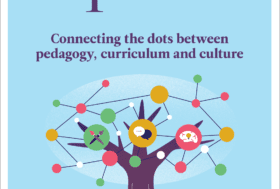This case study is part of a bitesize CPD learning unit on trauma.
In this audio clip, we hear from Jules Sanders and Megan Hornsby from School for Inspiring Talents. They discuss how they meet the needs of students who have experienced trauma in their specialist setting.
Further reading
Burke Harris N (2014) How childhood trauma affects health across a lifetime. TED. Available at: https://www.ted.com/talks/nadine_burke_harris_how_childhood_trauma_affects_health_across_a_lifetime
Burke Harris N (2018) The Deepest Well: Healing the Long-Term Effects of Childhood Adversity. London: Pan Macmillan.
Bombèr LM (2020) Know me to teach me: Differentiated discipline for those recovering from Adverse Childhood Experiences. Belper, UK: Worth Publishing.
Bombèr LM (2007) Inside I’m Hurting Practical Strategies for Supporting Children with Attachment Difficulties in Schools. Belper, UK: Worth Publishing.
Bombèr LM and Hughes DA (2013) Settling to learn. Belper, UK: Worth Publishing.
Escott, M (2019) One More Life Chance: How to support the journey from trauma to transformation. Fritton, UK: Rethink Press.
Felitta et al. (1998) Relationship of childhood abuse and household dysfunction to many of the leading causes of death in adults: The Adverse Childhood Experiences (ACE) Study. American Journal of Preventative Medicine 14(4): 245–58. Available at: https://www.ajpmonline.org/article/S0749-3797(98)00017-8/fulltext
Maslow AH (1943) A theory of human motivation. Psychological Review 50(4): 370–396. https://doi.org/10.1037/h0054346
Matthew J and Skuse T (2018) Trauma recovery model. Available at https://www.justiceinspectorates.gov.uk/hmiprobation/wp-content/uploads/sites/5/2022/04/Trauma-recovery-model.pdf
Perry BD and Winfrey O (2021) What Happened to You?: Conversations on Trauma, Resilience, and Healing. London: Pan Macmillan.
Saleebey D (1992) The Strengths Perspective in Social Work Practice. London: Pearson.
SAMHSA (2014) Concept of Trauma and Guidance for a Trauma-Informed Approach. Available at: https://store.samhsa.gov/sites/default/files/d7/priv/sma14-4884.pdf
Sunderland M (2019) Homepage. Trauma Informed Schools UK. Available at: https://www.traumainformedschools.co.uk/
You need to be logged in to view this video
I’m Jules Sanders and I’m the head of the multi-disciplinary team at School for Inspiring Talents. And I’m Megan Hornsby, mental health and wellbeing lead.
We’d like to start by telling you a little bit about our school to help you to understand the context that we work in. School for Inspiring Talents was co-founded by Mark Escott in 2014. It’s a specialist independent day school and it was established to meet the needs of children and young people who have experienced trauma. Our co-founder Mark was one of those children and he really is the epitome of what can be achieved if given one more life chance. Mark’s own troubled childhood led him to drugs and crime and finally a spell in a probation hostel where he witnessed firsthand the gulf between those working in the criminal justice and social care systems and those they were seeking to help. So this marked the start of his commitment to transform the life chances of children and young people and to establish the Life Chance Group. The group comprises of Life Chance Care, Life Chance Training, The Life Chance Trust, and, of course, Life Chance Education, which is where School for Inspiring Talents sits. As part of our specialist offer we have an on-site multidisciplinary team (MDT). In this team we are fortunate to have the support of a variety of therapists and specialists from both the mental health sector and education. Our MDT aims to ensure that the additional needs of students in our setting are met. To achieve this they may provide individual support, adjustments to provision, advice and guidance, or, training to staff.
Q: What makes your approach different from other schools?
Our unique therapeutic approach to education has enabled us to support many young people and their families. We currently have 60 children on roll and their ages range from 6 to 16. We understand the impact that difficult childhood experiences can have on a young person’s education, and on their social and emotional development. We provide a positive, nurturing school environment that aims to support students to overcome potential barriers to learning. We were the first trauma-informed school recognised in the UK by Trauma Informed Schools UK. All students who attend our school have an education, health and care plan – also known as an EHCP – and their primary needs are related to social, emotional and mental health.
And what makes us different is our therapeutic curriculum. We use every moment as a learning opportunity. We start with the basis that students need safety, and that this is rooted in secure relationships. Everything we focus upon is taught through a trauma-informed lens and we do our utmost to ensure that it’s not triggering. Where sensitive topics are discussed or taught, support is deliberate and planned for. We have a high staff-to-pupil ratio and our classes are small. Teachers and learning support assistants (LSAs) are supported by our multidisciplinary team to ensure that students’ needs are fully met. Today, we will be providing you with an insight into our approach to trauma, and any challenges or limitations we have discovered throughout our work.
Q: So what is meant by a trauma-informed approach?
Firstly, it’s important that we start with a shared definition of what we mean by ‘trauma’. American psychiatrist, Dr Bruce Perry – in his book written with Oprah Winfrey, What Happened to You? – describes trauma as a bad event or an experience that sticks. It’s one that you don’t forget. We often think of trauma as an experience that overwhelms the individual’s ability to cope, or to integrate the ideas and emotions involved in that experience. Dr Margo Sunderland, director of Trauma Informed Schools UK, would add that it is ‘an emotional response to an overwhelmingly painful and stressful event where there was no one there to help you with what was happening at the time’.
But an important point is that the definition ‘bad event’ is subjective. Which means it is not the event that determines whether it’s traumatic, but it’s the person’s experience of the event and the meaning that they make of it. So in other words, the experience and view of it can vary from person to person. What may be traumatic to you may not be traumatic to me, and vice versa.
As a school, we understand that trauma can significantly impact on the abilities of the student. It may make it difficult for them to create positive relationships with others, and it can create a negative internal working model for them. We know that experience of trauma can impact on behaviour, and it can also prevent the student from being able to concentrate, settle and learn.
Essentially, experiencing trauma can result in long-term effects on the brain and the body. Often in our school we see students who display behaviour that challenges. They may lash out, use unkind words, disrupt learning, and damage property. They can be hard to get alongside, having difficult experiences of relationships before, and they may have low self-esteem.
Trauma often links to adverse childhood experiences (ACEs). The ACEs study has better helped us to understand the impact of trauma on health, and our staff team all have training to help them to have an awareness of the study. Many of our students have a high number of ACEs, and our school was initially established to cater for students that had four ACEs or more.
The initial adverse childhood experiences study was published in 1998. The authors, Felitti and Anda et al., asked just over 17,500 adults ten questions about their adverse childhood experiences. These questions focused upon their early life before the age of 18, and their relationships during the time. Five questions were personal and five were related more towards relationships. The original ten questions that were asked covered the following: physical, sexual and verbal abuse; physical and emotional neglect; the experience of a family member who has mental health difficulties, is addicted to alcohol or other substances, or is in prison; witnessing domestic violence; or losing a parent to separation, divorce or death.
The study showed that as the number of adverse childhood experiences increased so too did the likelihood of poor physical and mental health. The higher the experience of adversity, the greater the impact. So as a negative experience increased, so did the likelihood of disruptive neurodevelopment; social, emotional and cognitive impairment; adoption of health harming behaviours; disease; disability; and even premature death.
Subsequent research has shown that if a young person has experienced three ACEs or more, they are three times more likely to experience academic failure, five times more likely to have attendance problems and six times more likely to have behavioural problems.
If you’re interested to learn more about the ACEs study, we would highly recommend watching a TED Talk by Dr Nadine Burke Harris it’s called ‘How childhood trauma affects health across a lifetime’. Alternatively, you could read the book by Dr Nadine Burke Harris, which is called The Deepest Well.
So when we offer this brief introduction to ACEs we offer it with a caveat. It’s vitally important that we do not consider the ACEs study without also reflecting on protective and mitigating factors, such as personal relationships, peer support, connections with school and community, and having positive role models. This is reflected in our school’s strength-based approach to trauma-informed care.
Our approach to supporting young people who’ve experienced trauma is based on what are widely known as the SAMHSA principles. These were originally developed in America by the Substance Abuse and Mental Health Services Administration (SAMHSA). The core principles developed by SAMHSA are these: awareness, safety, trustworthiness, choice, collaboration, and empowerment. They are principles that organisations across the country have adopted to considering their journey to become more trauma informed. We also have a high number of Trauma Informed Schools-trained staff and consider their PRRR model – protect, relate, regulate and reflect – alongside this.
So let’s very briefly talk about these (SAMHSA’s) guiding principles. Let’s start with awareness. We ensure that we have a very good awareness of the needs of our students, ensuring that we’ve created trauma profiles which detail what’s happened to them and how we can support them. We also create relational support plans which help us to support our students relational and regulation skills.
So now moving on to safety. We create a safe space in our classrooms for our students and we consider not only physical safety, ensuring, for example, that we don’t look exits if students need to leave, but we think about where students are seated and that we provide calm, safe spaces. We also work hard to establish psychological safety with a culture of warmth, unconditional positive regard, and social engagement.
So thinking about trust. We help our students to trust us. We create predictability. We plan for transitions, and we use schedules to create a sense of safety and security. We follow through with our promises and in circumstances where change is unavoidable we are transparent with our explanations.
We offer choices and compromise, and promote power with, rather than power over, strategies. We work collaboratively with our students, encourage student voice and empowerment through things like PSHE and student council. We don’t punish students for behaviours that are trauma symptoms, and we use the term ‘discipline’ as a tool to teach and to learn from.
Q: Are there any limitations to the approach that you provide?
Yes. There are, of course, limitations. We have a high staff–pupil ratio, which is unusual in many schools. However, this is absolutely necessary as our approach is extremely relational. We use the ‘team around the student’ approach – an approach developed by Louise Bomber that uses support from a team of in-school staff who work together to support the student and create an emotionally and physically safe, consistent and predictable environment. Of course, working so closely alongside our students who’ve experienced trauma, or who have social, emotional and mental health needs, can take its toll on our staff too. Our students need emotionally well-regulated adults who are able to provide essential calming and containment. To help our staff to feel able to do this we put a great deal of emphasis on supporting their mental health and resilience. As a setting, we provide supervision for all of our staff. We also have a number of staff ‘wellbeing champions’. We offer ‘Wellbeing Wednesdays’ as a chance to spend time together and we provide regular, reflective support slots to our staff team.
A difficulty that we face is secondary trauma or compassion fatigue, as working in the caring profession can be impactful on the wellbeing of our staff. Too often we believe that staff are like infinite sponges, able to absorb whatever it is that our students throw at them, and that it won’t have any negative effects on their wellbeing. The reality is that a truly trauma-informed school is not only one that is concerned about the impact of the trauma on the students that it cares for, but that it also needs to focus on the adults working so hard to meet the students’ needs.





